| Posted | Message |
|---|
Paul Bellamy
3/14/2008 7:57:06 PM | A conversation with Ed earlier today reminded me of some notes I took when I found Vic Maslen's Squadron Histories in the library a few weeks back.
Part of the things I jotted down were the pathfinder-equipped aircraft allocated to the 401st.
It seems that by August 1944 the dedicated 8AF Pathfinder unit at Alconbury was so overstretched providing aircraft and crews for every Bomb Group the order was made that every Bomb Squadron was to have two PFF equipped aircraft of it's own. Later on all the 401st's PFF aircraft were concentrated within the 615th BS.
I'll leave a proper write-up on the details of the equipment, and how it was used, for another day but in the meantime here's the list of the aircraft and their equipment installations:
PFF = H2X ground-scanning radar, fitted in a retractable housing replacing the ball turret. The display set was in the starboard side of the radio room, as seen in the photo below:

The radar image was shown on the display unit in the middle of the picture, the panel above carried various instruments and switches plus the computer on the right (the box with the vertical window and controls underneath). On the right of the desk is the junction box and the scanner control box.
The horn-shaped object at the top of the photo is simply a lamp to illuminate the upper panel.
Note the drawn blackout curtain on the left of the equipment, which was needed for the "Mickey operator" to be able to see the image on the circular screen in the middle of the instrument clearly.
GEE-H was a radio-location system developed from the OBOE system, to triangulate the aircraft's position by bouncing coded radio signals back from two known stations in the UK.
44-8153: IY-O, previously SC-Q. PFF
44-8258: IY-A. PFF
44-8259: IY-K, previously IW-G. PFF + GEE-H
44-8371: IY-M. PFF
44-8449: IY-F, previously IN-P. PFF + GEE-H
44-8454: IY-T, previously IN-C IY-F. PFF + GEE-H
44-8550: IY-D, previously IN-Q. PFF + GEE-H
44-8648: IY-N, previously IN-M. PFF
44-8653: IY-S. PFF
44-8707: IY-M. PFF + GEE-H
44-8708: IY-G. PFF + GEE-H
44-8812: IY-A. PFF + GEE-H
44-8825: IY-J. PFF + GEE-H
While digging for info earlier I unexpectedly found a photo of 44-8259 in flight:
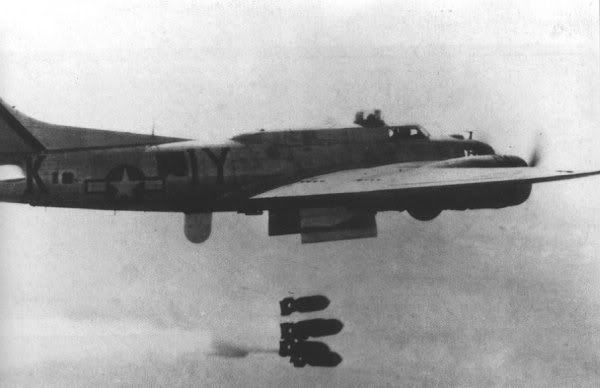
The H2X radome is clearly visible here in the extended position. One of the bombs looks to be fitted with a smoke marker, indicating the aircraft is operating, as intended, as the Lead Ship for the Group's bomb run.
The Strike Camera doors beneath the radio room are also seen open, which is something not often seen clearly in photos.
Sorry, I don't know which mission this is yet, but I'm working on it. 😉
All the best,
Paul
Paul Bellamy

|
Paul Bellamy
5/6/2008 6:57:36 PM | While looking into the B-17s currently flying or on display for the "B-17 Restoration" thread, I noticed that 44-8846 based in France could be of particular interest.
She was a Lockheed Vega-built B-17G from block 85, and was modified as a PFF ship. She flew six combat missions with the 511th Bomb Squadron, 351st Bomb Group out of Polebrook airfield before VE Day, and as such she is the only airworthy survivor of the 8th Air Force PFF Fortress, and even better was with the 94th CBW with the 401st Bomb Group. She theoretically may have led the 401st (as part of a Wing formation) on one of her six missions, but I'll have to check up on that.
After her 351st service she, along with most 1st Air Division PFF planes, was transferred to the 305th Bomb Group at Chelveston who had previously provided PFF cover for the 1st Air Division. The 305th stayed in Europe operating their specialist aircraft on mapping and photographic surveys, moving from England to Belgium then Germany before being disbanded at the end of 1946.
44-8846 passed through various units in Europe before finally returning to the USA, being flown to Ogden Air Material Command Centre, Hill AFB, Utah in February 1953.
In December 1954 she flew back to Europe, purchased by the French IGN (Institut Geographique National) to join their fleet of mapping B-17s, was retired from that task in 1979, and has remained based in France ever since.
After many years of airshow work, and a prominent role in the 1989 "remake" of Memphis Belle, she currently carries an incorrect olive drab over grey colour scheme and a mockup B-17F style nose.
44-8543 "Chuckie" under restoration at Ft. Worth, Texas may have been a PFF-modified airframe, and might be restored as one, but 44-8846 is an original 8AF, 94CBW, PFF ship with a combat record.
I personally would dearly love to see her flying restored to her original configuration (now that her owners have been able to resolve the EU flight insurance issues) and once again an example of wartime cutting-edge technology could grace the skies this side of the Pond.
Also possibly on display in France (she may be in storage) is 44-8889, which was allocated to the 8AF and arrived in England in February 1945.
Her wartime service history is unclear, but she too remained in Europe, also being flown back to the USA in 1953 and being sold to the IGN, flying back over the Atlantic in August 1953.
Let's hope I win the Lottery so I can put my money where my mouth is. 😉
TTFN,
Paul
Paul Bellamy

|
Paul Bellamy
5/27/2008 1:28:12 PM | I found this photo over the weekend on the 457th Bomb Group website, seemingly of another of the 401st's PFF ships which we don't currently have a picture of:
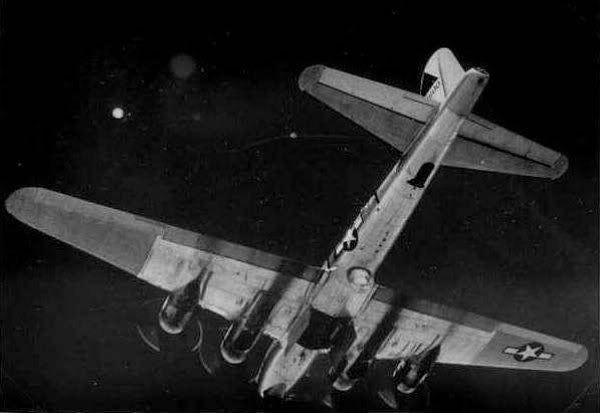
Captioned as being 42-97600 and dated as 28/2/45, Soest mission.
Must be an error there somewhere, as 42-97600 was lost in November 1944.
Curiouser still, this is a photo of a 351st and 401st Bomb Group aircraft, on the 457th Bomb Group's website, although they were all 94 Combat Wing groups.
Still, if it IS '600, (The serial number is not too clear) it shows her in her early markings with a blank fin triangle. The first 94CBW PFF aircraft were stationed with the 351BG at Polebrook and flew with any of the groups as required, so for ease of identification the Group Letter was omitted. This was prior to sufficient numbers of PFF-equipped aircraft allowed each group to have their own.
More to come,
Paul
Paul Bellamy

|
Paul Bellamy
5/27/2008 2:40:16 PM | Right, here's the current list of 94 Combat Wing-allocated Mickey Ships, with details and photos where possible.
All of these aircraft may have flown missions with the 401st prior to their dispersal amongst the Wing's groups in August 1944.
42-97600
B-17G-20-VE
Allocated to 401BG from 94CBW 20th August 1944, IW-Y (614th), IN-Y (613th).
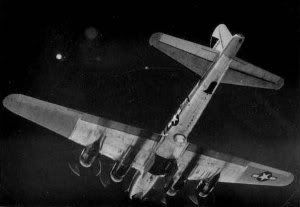
Lost to Flak 21st November 1944.
42-97601
B-17G-20-VE
Lost to Fighter 19th July 1944 while flying with 457th Bomb Group.
42-97636
B-17G-25-VE
Allocated to 401BG from 94CBW 26th August 1944, IY-H (615th).
Transferred to 305BG 1st May 1945.
42-97638
B-17G-25-VE
Allocated to 457BG from 94CBW 1st August 1944.
Lost to Flak 7th October 1944.
42-97649
B-17G-25-VE
Allocated to 457BG from 94CBW 1st August 1944.
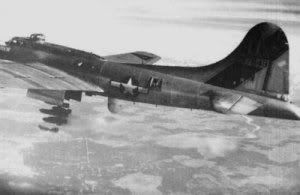
Transferred to 305BG 23rd May 1945.
42-97651
B-17G-25-VE
Allocated to 351BG from 94CBW 1st August 1944.
Transferred to 305BG May 1945.
42-97687
B-17G-25-VE
Allocated to 351BG from 94CBW 25th August 1944.
Transferred to 305BG May 1945.
42-97701
B-17G-25-VE
Allocated to 351BG from 94CBW 1st August 1944.
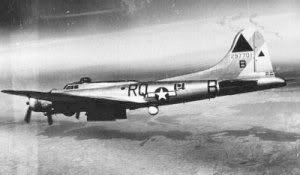
Transferred to 305BG 6th May 1945.
42-97947
B-17G-40-VE
Allocated to 401BG from 94CBW 20th August 1944, SC-U (612th).
Transferred to 305BG
42-97951
B-17G-40-VE
Allocated to 457BG from 94CBW 20th August 1944.

Lost to Flak while leading a bomb run near Nijmegen 17th September 1944.
42-97965
B-17G-40-VE
Allocated to 351BG from 94CBW 20th August 1944.
Crash-landed near Brussels 15th October 1944.
All the best,
Paul
Paul Bellamy

|